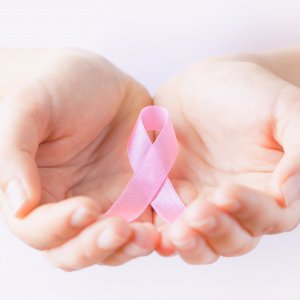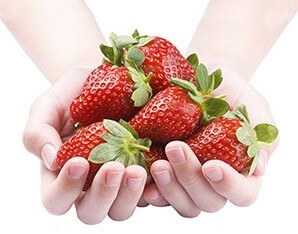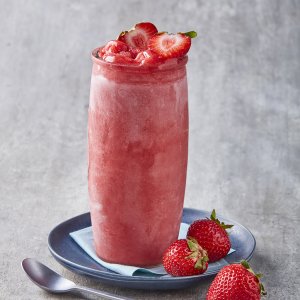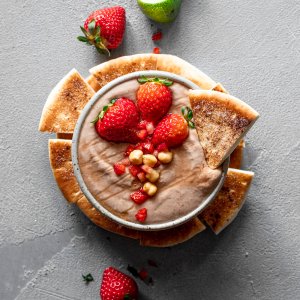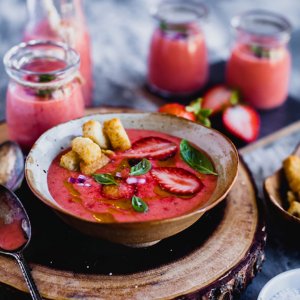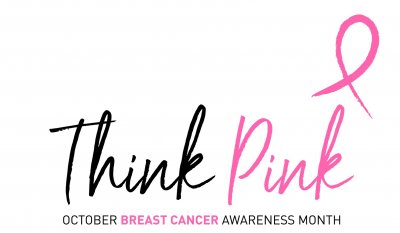
Breast Cancer Awareness Month 2020:
Think Pink, Eat Red!
Almost everyone reading this probably knows someone affected by breast cancer. My mother, grandmother, and aunt are the three people closest to me that were diagnosed. There are so many factors that affect whether a person gets breast cancer, how they react to treatment, and how long their recovery lasts.
In recognition of Breast Cancer Awareness Month, it may be worth a look at how something as simple as eating fruit may impact breast cancer risk and recovery.
Fruit in the Fight Against Breast Cancer
Eating fruit may help lower the risk of breast cancer. A review of 15 studies found women who ate the most fruit had a slightly lower risk of breast cancer compared to women who ate the least fruit.
Folate, one of the B vitamins found in fruits like strawberries and leafy green vegetables, is important in copying and repairing DNA.
“Getting enough folate may make it more likely that DNA is copied correctly when cells divide. This in turn may make it less likely cells become cancerous. For this reason, folic acid and multivitamins have been studied to see if they might lower the risk of breast cancer,” according to the Susan G. Komen Foundation.
A serving of strawberries contains 35 mcg of folate.
Strawberries & Breast Cancer Risk
Human studies related to strawberries and cancer risk compare groups of people who eat relatively high and low amounts of total fruit, dietary fiber, berries, or strawberries specifically. Based on a published review of the evidence, the American Institute for Cancer Research (AICR) reiterates on their website that, “People who eat more fruits have a lower risk of a wide range of cancers.”
The groups of people who eat the most strawberries are associated with a lower risk of estrogen receptor-negative (ER-) breast cancer (but not ER+) in an analysis of 20 observational population studies. Some clinical trials show strawberries associated with decreases in inflammation markers and increases in antioxidant defenses after consuming strawberries.
The fiber found in strawberries is linked with a lower risk of breast cancer while higher levels of vitamin C in a person’s diet and blood is associated with lower overall risk of cancer.
According to the American Institute for Cancer Research, “Strawberries hold an important role in a diet to reduce cancer risk.” They cite the following nutrients in strawberries to be of importance in fighting cancer: vitamin C, fiber, anthocyanins, phenolic acids (including ellagic acid), resveratrol, tannins, and flavan-3-ols.
Two mouse studies showed that strawberry extract slowed down or stopped breast cancer cells. Scientists hope to replicate these findings in humans.
Strawberries During Cancer Treatment
For those being treated for or recovering from cancer, eating can be difficult. Changes in appetite, the way foods taste, as well as potential swallowing difficulties, makes finding the right foods important for patients. For instance, many cancer patients going through chemotherapy find cold or room temperature meals more appealing than hot ones.
Ripe strawberries provide a soft texture that may be easier to chew and swallow for those with mild difficulties. When pureed, they provide a nutritious addition to smoothies, soups, and hummus.
Below are dietitian recommended strawberry recipes that can be served cold and give a boost of antioxidants.
Organic vs. Conventional: Which is better?
The Susan G. Komen Foundation states on their website that, “Research shows organic foods are no more nutritious or better for your health than foods farmed by conventional methods. Organic foods do not appear to lower the risk of breast cancer.”
According to the American Cancer Society, the benefits of eating fresh fruits and vegetables outweigh any health risks linked with pesticide residue.
Both organic and conventional fruits and veggies are important parts of the diet. Buying fresh, frozen, or canned produce and thoroughly rinsing fresh produce when preparing is always a good idea.
This month when you “think pink,” eat red!
TERMS AND CONDITIONS • PRIVACY • CONTACT • SCHOLARSHIP PROGRAM • INDUSTRY & TRADE • INDUSTRY NEWS • EN ESPAÑOL • Powered by Team of Horses • ©2010-2024 California Strawberry Commission. All Rights Reserved.

